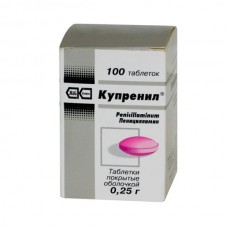Expiration date: 07/2026
The composition and form of issue:
Tablets, film-coated 1 tablet contains active substance:
penicillamine 250 mg
auxiliary substances: potato starch — 43,75 mg lactose monohydrate — 166,25 mg povidone 25 mg talc 10 mg magnesium stearate 5 mg
shell: hypromellose — of 10.51 mg of macrogol 4000 — 0.8 mg titanium dioxide (E171) to 2.51 mg dye azorubin (?122) to 1.18 mg
in blister packs of PVC and aluminium foil 15 PCs per pack carton 2 blisters in a jar or 100 PCs the paper cartons 1 Bank.
Pharmacological action:
Complexing immunosuppressive, an overwhelming synthesis of collagen. Forms water-soluble complexes with ions of the metals copper, mercury, lead, iron, arsenic, calcium, zinc, cobalt, gold and removes them through the urine. Also forms soluble compounds with cystine, preventing formation of cystine stones in the kidneys. Inhibits the function of T-helper cells, inhibits chemotaxis of neutrophils and the secretion of lysosomal enzymes, enhances macrophage activity. Reduces pathological makroglobulinov, including rheumatoid factor. Suppresses the synthesis of collagen and normalizes the ratio between the soluble and insoluble fractions, thus preventing the progression of sclerotic changes in tissues.
Pharmacokinetics:
Rapidly absorbed from the gastrointestinal tract. Cmax achieved through 1.5 hours Biotransformiroetsa in the liver. Excreted by the kidneys mainly as metabolites. T1/2 — 24-75 h
Indications:
The Wilson's disease, intoxication with copper, mercury, lead, gold. Cystine nephrolithiasis, hemosiderosis, rheumatoid arthritis, scleroderma, alcoholic cirrhosis with hepatomegaly, fibroelastosis variant of glomerulonephritis.
Contraindications:
Hypersensitivity, agranulocytosis, systemic lupus erythematosus, myasthenia gravis, renal failure, pregnancy, breast-feeding.
Application of pregnancy and breast-feeding:
Contraindicated in pregnancy. At the time of treatment should stop breastfeeding.
Side effects:
From the digestive system: anorexia, nausea, vomiting, diarrhea, aphthous stomatitis, glossitis, intrahepatic cholestasis, pancreatitis.
With the hematopoietic system: eosinophilia, thrombocytopenia, leukopenia, anemia (hemolytic or aplastic), agranulocytosis.
The respiratory system: interstitial pneumonia, diffuse fibrosing alveolitis, goodpasture's syndrome.
CNS and peripheral nervous system: a complete loss or distortion of taste sensations rarely — reversible polyneuritis (associated with vitamin B6 deficiency).
Dermatological reactions: skin rash, epidermal necrolysis, alopecia.
Allergic reactions: allergic alveolitis, fever, polymyositis, dermatomyositis, volchanochnopodobny reactions (arthralgia, myalgia, erythematous rash, the appearance of antinuclear antibodies and antibodies to DNA).
Other: jade, breast enlargement with the development of galactorrhea (in women), male.
Drug interactions:
Can not be used with drugs, oppressive blood. Antimalarial drugs, levamisole and phenylbutazone increase the likelihood of side effects Kuprenila. Kuprenil is an antagonist of vitamin B6.
Method of application and dose:
Inside, at least 30 minutes before eating, squeezed water or 2 hours after meals or other drugs.
Wilson Disease-Konovalova
Adults — 1.5–2 g/cen in fractional doses. After remission of the disease the dose can be reduced to 0.75 or 1 g/day. In patients with negative copper balance should apply the minimum effective dose of penicillamine.
A dose of 2 g per day to apply for not more than 1 year.
Elderly patients — 20 mg/kg/day in fractional doses. The dose should be selected in such a way as to achieve remission of the disease and keep negative balance of copper.
Children — usually 20 mg/kg/day in fractional doses. The minimum dose — 500 mg/day.
Cystinuria
It is best to establish a minimum effective dose after quantifying the concentration of amino acids in urine by chromatographic method.
Dissolution of cystine stones
Adults: 1-3 g/day in fractional doses. It should keep the cystine concentration in the urine less than 200 mg/L.
Warning cystine lithiase
Adults — 0,5–1 g/day until the concentration of cystine in the urine is below 300 mg/L.
Elderly patients are prescribed the lowest dose until the concentration of cystine in the urine less than 200 mg/L.
Children prescribed minimum dose, which allows to achieve concentration of cystine in the urine less than 200 mg/L.
During treatment it is recommended to drink plenty of fluids — at least 3 liters per day. The patient should drink 500 ml of water before going to sleep, and then 500 ml at night when urine is more concentrated and more acid than during the day. Generally, the more liquid the patient drank, the lower his need for penicillamine.
It is also recommended that a diet with a low content of methionine to reduce the synthesis of cystine. Due to the low protein content, this diet is not recommended for children in the growth period and for pregnant women.
Lead poisoning
Adults — 1-1. 5 g per day in fractional doses until the selection lead to the urine in the range of 0.5 mg/day.
Elderly patients — 20 mg/kg/day in fractional doses until the selection lead to the urine in the range of 0.5 mg/day.
Children — 20 mg/kg/day.
Rheumatoid arthritis
Adults — 250 mg/day for the first month of treatment. Then increase the dose every 4-12 weeks to 250 mg to achieve remission of the disease. Then apply the minimum effective dose, which allows to slow down the symptoms of the disease. If within 6 months of drug therapeutic effect is not achieved, treatment should be discontinued.
Maintenance dose is usually 500-750 mg/day. Do not exceed the dose of 1.5 g/day. After remission of the disease lasts 6 months, the dose of drugs recommended to gradually reduce to 250 mg every 12 weeks.
Elderly patients the initial dose should not exceed 250 mg/day for the first month of treatment. Then the dose can be increased every 4 to 12 weeks 250 mg to achieve remission of the disease. Do not exceed the dose of 1 g of the drug per day.
Children 15-20 mg/kg/day. The initial dose is 2.5–5 mg/day, it can increase gradually every 4 weeks for 3-6 months to a minimum effective dose but not more than 500 mg.
Systemic sclerosis
250 mg/day for the first month of treatment. Then increase the dose every 4-12 weeks to 250 mg to 1 g/day with a subsequent decrease to 250-500 mg/day. The effect is evaluated after 6-12 months of treatment.
Overdose:
Treatment: if necessary, symptomatic therapy.
Precautions:
Treatment Kuprenilom is carried out under strict clinical and laboratory monitoring. At the beginning of treatment are detailed (including platelets) CBC and urinalysis every 3 days, then 1 time a week. Monthly should monitor liver function, kidneys, a neurological examination of the patient. In the case of the development on the background of treatment with Kuprenilom fever, lesions of lungs, liver, expressed hematological and neurological disorders, myasthenia gravis, hematuria, volchanochnopodobny reactions and other severe side effects of the drug overturned and if necessary, prescribe corticosteroids. Patients with disorder of renal function the dose reduced. In the case of isolated proteinuria, if she is not growing and does not exceed 1 g/day, treatment with Kuprenilom can continue.
In view of the influence Kuprenila for collagen formation, surgical interventions (including dental) should be performed with extreme caution.
Patients with Wilson's disease or cystinuria simultaneously with Kuprenilom prescribers of vitamin B6 (due to dietary restrictions that apply in these diseases). With the development of symptoms of vitamin B6 deficiency on the background of prolonged treatment with Kuprenilom additionally prescribe of 25 mg of pyridoxine per day.
In the case of the previous inefficiencies and abolition of drugs gold Kuprenil shall be appointed not earlier than after 6 months.
If the patient needs the administration of iron preparations in the therapy with Kuprenilom, should observe a two-hour interval between their admission.


